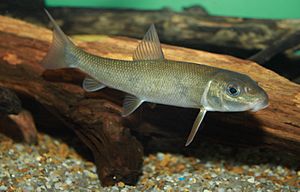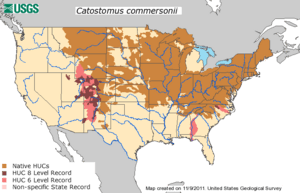White sucker facts for kids
Quick facts for kids White suckerTemporal range: Early Pleistocene to recent
|
|
|---|---|
 |
|
| Conservation status | |
| Scientific classification | |
 |
|
| Distribution in the United States (also occurs in Canada) | |
| Synonyms | |
|
The white sucker (Catostomus commersonii) is a common freshwater fish. You can find it in rivers, streams, and lakes across North America. It lives mostly in the upper Midwest and Northeast of the United States. But it can also be found as far south as Georgia and New Mexico.
This fish is called a "sucker" because of its special mouth. It has thick, fleshy lips that help it suck up food from the bottom of the water. It eats things like tiny plants and other organic matter.
People sometimes call the white sucker by other names. These include bay fish, brook sucker, common sucker, and mullet. It looks a lot like the Longnose sucker (C. catostomus), so they are often confused.
Contents
About the White Sucker
The white sucker is a long fish with a round body. Its back and sides can be dark green, grey, copper, brown, or black. Its belly is usually light. This fish has a homocercal tail, which means its top and bottom parts are the same size. It also has cycloid scales, which are smooth and round.
When fully grown, a white sucker can be 12 to 20 inches long. It can weigh between 2 and 6 pounds. Its mouth is on the bottom of its head. This helps it suck food from the riverbed.
White suckers are often mistaken for other types of suckers or redhorse fish. But you can tell them apart by their lateral line. This line runs along the side of the fish. It has 55 to 85 small scales.
Where White Suckers Live
White suckers are very good at living in different places. They can even handle changes in their environment.
You usually find them in small streams, rivers, and lakes. These are mostly in the Midwest and on the East Coast of the United States. White suckers can also live in cloudy or polluted water. However, they have trouble laying eggs in acidic water. This kind of water can be caused by acid rain.
What White Suckers Eat
The white sucker is a bottom feeder. This means it eats food from the bottom of the water. It uses its fleshy lips to suck up sediments and other small things.
It will eat almost anything it can find. Most often, it eats small invertebrates (like insects), algae, and plant matter. Bigger fish often hunt and eat white suckers. These include fish like walleye, trout, bass, northern pike, catfish, muskellunge, and sauger.
White Sucker Reproduction
White suckers usually lay their eggs in April and May. They prefer shallow water or streams. The process of laying eggs, called spawning, might start when the water temperature changes. It can also be triggered by runoff from melting snow.
During spawning, two or more male suckers might gather with one female. The female can release up to 10,000 eggs. The males then fertilize these eggs.
White Suckers and Humans
White suckers are very common fish. People usually do not fish for them to eat, even though some say they taste good. They are most often used as bait. Young white suckers are sold as "sucker minnows" for fishing.
When people do eat white suckers, the fish is often processed. It is then sold under the name of mullet. The world record for catching a white sucker was set in 1984. It was a 6-pound, 8-ounce fish caught in the Rainy River near Loman, Minnesota.
Ancient White Suckers
Scientists have found fossils of white suckers in the United States. Some of these fossils are very old. They date back to the Early Pleistocene period. This was about 1.8 million years ago!
See also
 In Spanish: Catostomus commersonii para niños
In Spanish: Catostomus commersonii para niños


